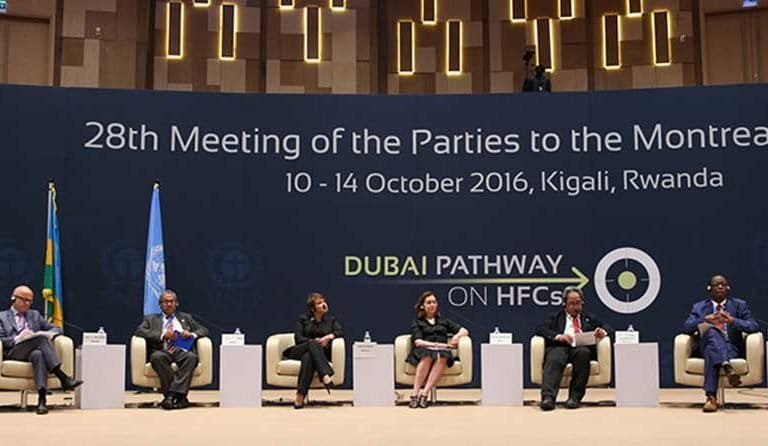A new report suggests that the rapid acceleration of climate change has pushed the Earth systems humanity relies upon to the brink of collapse, placing the world on a “devastating…
Verra, the world’s largest certifier of carbon credits, has released an update for calculating the climate benefits of the REDD forest conservation projects it certifies. The U.S.-based nonprofit said the…
A team of scientists from the Indian Institute of Science (IISc) and Japan’s Niigata University have unearthed water droplets trapped in mineral deposits in the Kumaon mountains in the central…
“It's not going in the right direction yet,” Pierre Friedlingstein tells Mongabay of the effort to meet the Paris Agreement goals; a member of the IPCC and a climate professor, he says he’s mildly optimistic about the trend in global emissions.
The world needs to ramp up action to address climate change, according to a major report from the United Nations released Sept. 8. Meeting agreed-upon climate goals requires “phasing out…
Andres Peña Castro and his team didn’t set out to track sea ice. Their original plan was to quantify the interactions between ocean, earth and atmosphere to be able to…
The world won’t be able to limit global temperature rise as called for in the 2015 Paris Agreement without eventually eliminating the use of fossil fuels, according to Simon Stiell,…
Humans must make “deep, rapid, and sustained” cuts to greenhouse gas emissions to avoid the worst effects of climate change, according to the United Nations’ Intergovernmental Panel on Climate Change…
Analysis of 40 years of climate temperature data shows a connection between Amazon tree loss and Tibetan snow decrease via a 20,000-kilometer oceanic and atmospheric pathway. West Antarctica is also impacted.
Brazilian scientist Antonio Donato Nobre has long been a student of the Amazon Rainforest. An agronomist with a master's degree in tropical biology and a Ph.D. in Earth science, Nobre…
A new study conveys a dire warning for the future: multiple tipping points could be triggered if global warming exceeds the critical threshold of 1.5°C. Published this week in Science,…
KATHMANDU — Thousands of farmers in Nepal's fertile southern plains, the country’s rice bowl, face a double whammy of a fertilizer shortage and inadequate monsoon rains. This is likely to…
Just weeks after visiting a patch of Malaysian rainforest, Mongabay founder Rhett A. Butler learned it had been logged for wood chips to supply a paper plant. A teenager at…
The world’s largest bank of the partially decomposed plant matter known as peat in the tropics is even more extensive than initially thought, according to a new study. The peatlands…
Freshwater’s life-giving benefits are being gravely threatened by humanity’s manipulations of the hydrological cycle, impacting the climate and biodiversity, and undermining Earth’s operating system.
Scientists already knew that where the western Amazon rainforest sits today was once a vast wetland, almost four times the size of Texas and periodically flooded by pulses of seawater.…
A new book by Wake Smith, “Pandora’s Toolbox,” explores controversial ideas for artificially cooling the planet. Smith discusses the hopes and hazards of geoengineering in an exclusive Mongabay interview.
In the past, ocean carbon data was sparse, mostly gathered by ships. But the future of monitoring belongs to robot floats that deliver real-time data across vast oceans — even in the remote Antarctic Southern Ocean.
Initiatives to inject billions of aerosol particles into the stratosphere to deflect solar rays and cool Earth are too risky to go forward; governments must act fast to rein in potentially disastrous planetary-scale solar geoengineering, say critics.
This is the wrap-up article for our four-part series “The Congo Basin peatlands.” Read Part One, Part Two, Part Three and Part Four. In the first half of December, Mongabay…
This is the fourth article in our four-part series “The Congo Basin peatlands.” Read Part One, Part Two and Part Three. The muddy cores that Ian Lawson and his colleagues…
This is the third article in our four-part series “The Congo Basin peatlands.” Read Part One, Part Two and Part Four. The logging concession moratorium signed in 2002 was supposed to shore…
This is the second article in our four-part series “The Congo Basin peatlands.” Read Part One, Part Three and Part Four. The announcement came in mid-2019: A pool of oil lay deep…
This is the first article in our four-part series “The Congo Basin peatlands.” Read Part Two, Part Three and Part Four. The notion seemed straightforward: A massive swamp in the Congo Basin…
For 20 years, researchers stared at the dark side of the moon to measure its faint but visible “earthshine,” a glow created by sunlight reflecting off Earth and onto the…
With COP26 showing no sign of a CO2 reduction breakthrough, researchers are touting various atmospheric methane removal strategies. But is there the time, money and commitment to implement? And what are the risks?
The greenhouse gases humans have released into the atmosphere over the past 100 to 150 years, mostly in the form of carbon dioxide, have led to a 1.1° Celsius (2°…
The push to halt climate change too often neglects the interconnected issue of biodiversity loss, according to a recent report from a panel of scientists with the United Nations. “What…
Vast terrains dominated by grasses, shrubs or sparse trees, rangelands are more than unproductive places where reticent herders graze their livestock and wildlife browse dry — or green, if lucky…
Created in 1987, the pathbreaking treaty not only phased down scores of ozone depleting chemicals and is helping heal the ozone hole — it also offers a flexible, regularly updating example for future environmental treaties.


































































